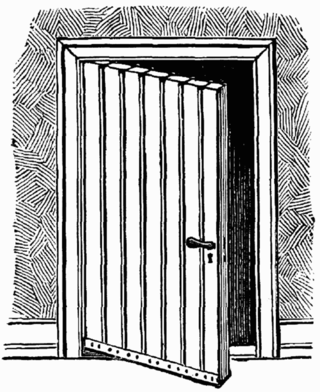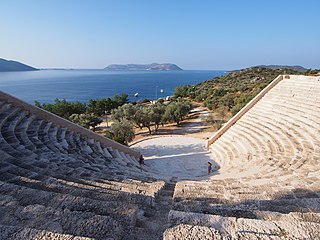
A door is a hinged or otherwise movable barrier that allows ingress (entry) into and egress (exit) from an enclosure. The created opening in the wall is a doorway or portal. A door's essential and primary purpose is to provide security by controlling access to the doorway (portal). Conventionally, it is a panel that fits into the doorway of a building, room, or vehicle. Doors are generally made of a material suited to the door's task. They are commonly attached by hinges, but can move by other means, such as slides or counterbalancing.

Lumber is wood that has been processed into uniform and useful sizes, including beams and planks or boards. Lumber is mainly used for construction framing, as well as finishing. Lumber has many uses beyond home building. Lumber is referred to as timber in the United Kingdom, Europe, Australia, and New Zealand, while in other parts of the world the term timber refers specifically to unprocessed wood fiber, such as cut logs or standing trees that have yet to be cut.

Engineered wood, also called mass timber, composite wood, human-made wood, or manufactured board, includes a range of derivative wood products which are manufactured by binding or fixing the strands, particles, fibres, or veneers or boards of wood, together with adhesives, or other methods of fixation to form composite material. The panels vary in size but can range upwards of 64 by 8 feet and in the case of cross-laminated timber (CLT) can be of any thickness from a few inches to 16 inches (410 mm) or more. These products are engineered to precise design specifications, which are tested to meet national or international standards and provide uniformity and predictability in their structural performance. Engineered wood products are used in a variety of applications, from home construction to commercial buildings to industrial products. The products can be used for joists and beams that replace steel in many building projects. The term mass timber describes a group of building materials that can replace concrete assemblies.

Plaster is a building material used for the protective or decorative coating of walls and ceilings and for moulding and casting decorative elements. In English, "plaster" usually means a material used for the interiors of buildings, while "render" commonly refers to external applications. The term stucco refers to plasterwork that is worked in some way to produce relief decoration, rather than flat surfaces.

Drywall is a panel made of calcium sulfate dihydrate (gypsum), with or without additives, typically extruded between thick sheets of facer and backer paper, used in the construction of interior walls and ceilings. The plaster is mixed with fiber ; plasticizer, foaming agent; and additives that can reduce mildew, flammability, and water absorption.

Building material is material used for construction. Many naturally occurring substances, such as clay, rocks, sand, wood, and even twigs and leaves, have been used to construct buildings and other structures, like bridges. Apart from naturally occurring materials, many man-made products are in use, some more and some less synthetic. The manufacturing of building materials is an established industry in many countries and the use of these materials is typically segmented into specific specialty trades, such as carpentry, insulation, plumbing, and roofing work. They provide the make-up of habitats and structures including homes.

A window blind is a type of window covering. There are many different kinds of window blinds which use a variety of control systems. A typical window blind is made up of several long horizontal or vertical slats of various types of hard material, including wood, plastic or metal which are held together by cords that run through the blind slats. Vertical blinds run along a track system which can tilt open and closed and move side-to-side. Window blinds can be manoeuvred with either a manual or remote control by rotating them from an open position, with slats spaced out, to a closed position where slats overlap and block out most of the light. There are also several types of window coverings, called shades, that use a single piece of soft material instead of slats.

A mattress is a large, usually rectangular pad for supporting a lying person. It is designed to be used as a bed, or on a bed frame as part of a bed. Mattresses may consist of a quilted or similarly fastened case, usually of heavy cloth, containing materials such as hair, straw, cotton, foam rubber, or a framework of metal springs. Mattresses may also be filled with air or water.

A trunk, also known as a travel trunk, is a large cuboid container designed to hold clothes and other personal belongings. They are most commonly used for extended periods away from home, such as for boarding school, or long trips abroad. Trunks are differentiated from chests by their more rugged construction due to their intended use as luggage, instead of the latter's pure storage.

Military vehicles are commonly armoured to withstand the impact of shrapnel, bullets, shells, rockets, and missiles, protecting the personnel inside from enemy fire. Such vehicles include armoured fighting vehicles like tanks, aircraft, and ships.

A lath or slat is a thin, narrow strip of straight-grained wood used under roof shingles or tiles, on lath and plaster walls and ceilings to hold plaster, and in lattice and trellis work.

A corn crib or corncrib is a type of granary used to dry and store corn. It may also be known as a cornhouse or corn house.

Precast concrete is a construction product produced by casting concrete in a reusable mold or "form" which is then cured in a controlled environment, transported to the construction site and maneuvered into place; examples include precast beams, and wall panels for tilt up construction. In contrast, cast-in-place concrete is poured into site-specific forms and cured on site.

A moving floor is a hydraulically-driven moving-floor conveyance system for moving bulk material or palletized products, which can be used in a warehouse, loading dock or semi-trailer. It automates and facilitates loading and unloading of palletized goods by eliminating the need for a forklift to enter the trailer. In a truck-based application, the system can quickly unload loose material without having to tip the trailer or tilt the floor as with other dumping systems. In a bulk material application such as a waste facility, these systems can reduce double handling by allowing any vehicle to deliver material to the conveying floor and move heavy bulk materials to subsequent stages of a process. For bagged waste, the system can also be combined with bag openers.

A flexible intermediate bulk container (FIBC), jumbo, bulk bag, super sack, big bag, or tonne bag is an industrial container made of flexible fabric that is designed for storing and transporting dry, flowable products, such as sand, fertilizer, and granules of plastic.

Upcycling, also known as creative reuse, is the process of transforming by-products, waste materials, useless, or unwanted products into new materials or products perceived to be of greater quality, such as artistic value or environmental value.

A shinai (竹刀) is a Japanese sword typically made of bamboo used for practice and competition in kendō. Shinai are also used in other martial arts, but may be styled differently from kendō shinai, and represented with different characters. The light, soft wood used in a shinai distinguishes it from other wooden swords such as a bokken (木剣), which is generally made of heavier, sturdier wood.
Shop fitting (shopfitting) is the trade of fitting out retail and service shops and stores with equipment, fixtures and fittings. The trade applies to all kinds of outlets from small corner shops to hypermarkets. A shop fitter executes planning, designs shop layout and installs equipment and services. A shop fitting firm typically incorporates professional expertise in interior design, manufacturing of bespoke furniture, signage and fittings and purchasing of retail equipment.

Wattle and daub is a composite building method used for making walls and buildings, in which a woven lattice of wooden strips called "wattle" is "daubed" with a sticky material usually made of some combination of wet soil, clay, sand, animal dung and straw. Wattle and daub has been used for at least 6,000 years and is still an important construction method in many parts of the world. Many historic buildings include wattle and daub construction.

Antiphellus or Antiphellos, known originally as Habesos, was an ancient coastal city in Lycia. The earliest occurrence of its Greek name is on a 4th-century-BCE inscription. Initially settled by the Lycians, the city was occupied by the Persians during the 6th century BCE. It rose in importance under the Greeks, when it served as the port of the nearby inland city of Phellus, but once Phellus started to decline in importance, Antiphellus became the region's largest city, with the ability to mint its own coins. During the Roman period, Antiphellus received funds from the civic benefactor Opramoas of Rhodiapolis that may have been used to help rebuild the city following the earthquake that devastated the region in 141.



















